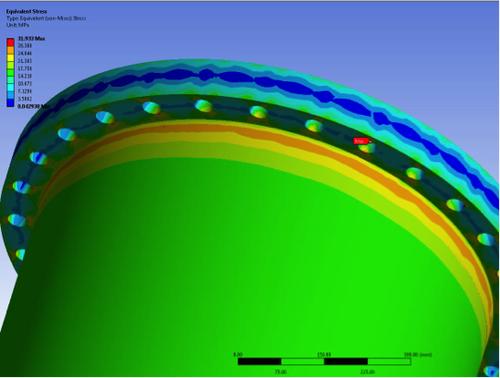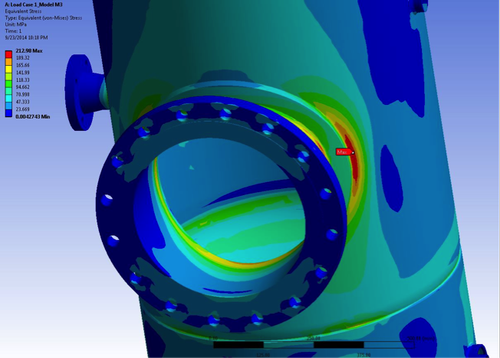Identifying and Reducing Stresses in Pressure Vessels
June 26, 2015

Pressure vessels are part of common equipment utilized in plants to store liquids and gases under high pressure. It is certain that pressurized fluids will develop stresses in the vessel, which when exceeds failure limits, will lead to hazardous incidents and fatalities.
Fatalities due to accidents directly involved with pressure vessels are showing no signs of reduction. It is therefore mandatory for engineers to design pressure vessels that withstand stresses effectively without failure. The design of these vessels is usually governed by standard codes such as BPVC defined by ASME.
MORE FROM DESIGN NEWS: Engineering Disasters: 1984 Romeoville Refinery Blast
To determine the effects of primary and secondary stresses, a vessel design can be studied using finite element analysis. Through proper application of boundary conditions such as pressure, temperature, and material properties, finite element solvers can provide stress distribution across the vessel geometry. The Division 3 of ASME BPVC Section VIII provides the procedure to design pressure vessels using FEA, which must be followed to determine limiting pressure values, stress intensity factor, and thickness of the shell.


Based on the values obtained, the CAD model can be prepared to perform structural analysis. By converting the model into a mesh of elements and applying required boundary conditions, a finite element model will be created. The model can be solved using stress and thermal equations to determine stress distribution and deformation in the geometry. As mentioned, stresses are most commonly found near the junctions, such as nozzles meant for pressure relief, which weaken the pressure vessel design. The results of finite element analysis can be utilized to identify such regions, and actions can be taken to improve the design.
Modification can include implementing reinforcement pads around the nozzle area or increasing the thickness of the shell. Joints of enclosure heads are also one of the areas with high stress concentration, which can be eliminated by increasing the skirt length at the end of enclosure heads.
MORE FROM DESIGN NEWS: The Case of the Shocking-Hot TV Cables
However, despite designing the vessel to withstand maximum stresses, the life of a pressure vessel depends majorly on the fatigue effect that results from cyclic application of pressure forces. A prolonged exposure to high-pressurized fluids results in the development and growth of cracks, leading to catastrophic failure. This is one of the major causes of accidents resulting from pressure vessels, which can be eliminated by performing fatigue analysis.
The ASME Section VIII Division 2 Part 5 provides the details on calculating fatigue for pressure vessels by determining the number of useful design cycles prior to failure. Considering the fatigue strength reduction factor and the fatigue penalty factor, the effective alternating stress amplitude can be calculated, the value of which can be further utilized to determine the number of design cycles.
The images shown above are the stress results obtained through FEA on a pressure vessel, clearly indicating the joints and junctions being the most sensitive to stress concentration. Designed for a pressure cycle of 80 psi to 115 psi, fatigue analysis for the pressure vessel was performed based on the ASME calculations, which showed that the pressure vessel was under-designed and would fail prematurely than the expected number of cycles. These results helped in improvising the pressure vessel design further by increasing the shell thickness and providing more strength near the junctions and nozzles.
Mehul Patel specializes in handling computational fluid dynamics projects for the automobile, aerospace, oil and gas, and building HVAC sectors. He works as a CFD consultant with Hi-Tech CFD for the past five years and has successfully executed numerous CFD projects of high complexity. He is an expert in turbomachinery, gas dynamics, combustion, fluid dynamics, multiphase flow analysis, and computational fluid dynamics, etc.
About the Author(s)
You May Also Like



